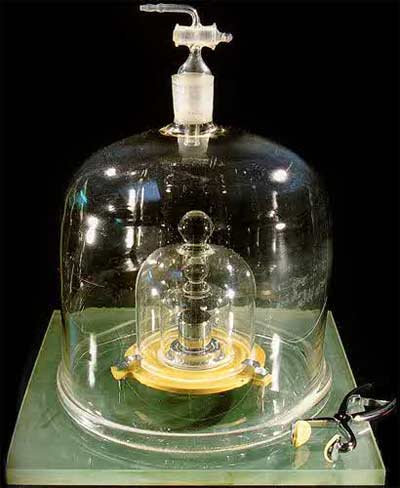A question that is too easy for a… meat vendor at the market, but too difficult for physicists!
It’s not difficult because of complex concepts, but rather due to its specific yet ambiguous definition. The definition of the kilogram is quite authoritarian: “The kilogram is a unit of mass. It is equal to the mass of the international prototype of the kilogram.”

The 1 kg prototype in France (Photo: physics.nist.gov)
The kilogram prototype at the International Measurement Institute is a small cylinder made of a platinum-iridium alloy, kept like a treasure since 1889 in Paris, France. At that time, this alloy was chosen for its durability, demonstrated by its resistance to corrosion and acids, and due to its high density, which minimizes the buoyant force of air when weighed.
It is placed under three glass bell jars, protected from dust inside a steel cabinet with three locks, each held by a different leader. Every year, these three individuals meet to “look” at the kilogram prototype without touching it.
Occasionally (once every 50 years), the prototype is taken out to compare with a “secondary standard” after being “cleaned” through a complicated procedure using camel skin soaked in a mixture of alcohol and ether.
The kilogram standard is very difficult to replicate and disseminate, as it cannot be defined in “written terms“. One can only describe what it is and where it is placed. For instance, the definition of a meter is: 1 meter is the length that light travels in a vacuum in a time interval of 1/299,792,458 seconds; while a second is defined based on the cesium-133 atom. All well-equipped laboratories can trace the fundamental units based on these definitions, except for the kilogram.
An important issue is that currently, the kilogram tends to lose mass over time due to wear. A 10^-3 error in common measurements is negligible, but when it comes to accurately determining a physical unit, such an error is significant and cannot be overlooked.
Scientists are currently grappling with this issue. A new approach has been proposed, which involves the Watt balance that uses the comparison of electromagnetic force with mechanics. The project aims to link the kilogram with an invariant quantity: Planck’s constant, a fundamental constant of quantum theory that represents the smallest quantum. The French National Measurement Institute also has one of these scales, the latest model located at the national laboratory in Trappes.
Currently, the Watt balance is being evaluated as an effective solution to this problem.
The kilogram prototype can still rest assured in its place under the three bells in Sèvres. However, in 15 to 20 years, it may very well be relegated to the museum of modern science.


















































